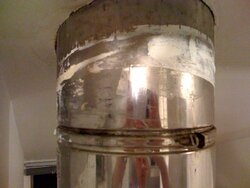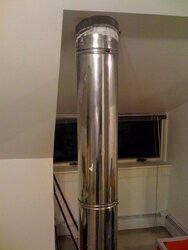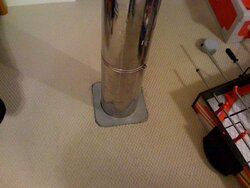I've got a stainless steel class A chimney that goes through the center of my house. The stove is on the first floor; there is an interior double wall flue that feeds into the class A SS chimney just below the ceiling on the first floor. This goes through a closet on the 2nd floor and through the middle of a finished attic on the 3rd floor. My son mentioned to me that the 3rd floor smelled a bit like smoke a little while back so I jumped up and ran upstairs to check things out. It did smell a bit like smoke, nothing visible (there is a detector up there, never went off).
So I checked the chimney and saw what looked like some soot just above one of the seams between the 2 foot SS chimney segments (see closeup photo). I looked at the ceiling where the chimney penetrates and saw a little bit of soot as well (recently painted the room so I know it's new).
After performing more tests I determined that it happened when I start fires in a cold stove, though I have yet to see smoke, there is a faint smell. It seems that when there is no draft (cold stove), some smoke may have wandered out this seam, but once a draft is pulling, it probably is not puffing out the seam, but just the opposite. Just a theory.
So I decided to take the band/clasp off the seam between the two two 2-foot SS Chimney segments and discovered that the chimney is a bit crooked; the top section tilts causing almost a 1/4th inch gap between SS chimney segments one one side and a proper mating on the other side. The chimney doesn't wiggle so I couldn't force it straight for a proper mating all the way around. I then put the band back on and tightened it quite a bit.
No smell since, though I'm still a bit concerned as the gap is still there.
Question: How do these chimney segments interlock? Does a 1/4th inch matter? What other tests can I perform to ensure this is working properly? Any recommendations?
About the attached picture; on the closeup you can see a bit of the soot to the top/left of the seam/band. The rest of the mess is paint and dirt that has always been there. Any help/suggestions would be greatly appreciated.
So I checked the chimney and saw what looked like some soot just above one of the seams between the 2 foot SS chimney segments (see closeup photo). I looked at the ceiling where the chimney penetrates and saw a little bit of soot as well (recently painted the room so I know it's new).
After performing more tests I determined that it happened when I start fires in a cold stove, though I have yet to see smoke, there is a faint smell. It seems that when there is no draft (cold stove), some smoke may have wandered out this seam, but once a draft is pulling, it probably is not puffing out the seam, but just the opposite. Just a theory.
So I decided to take the band/clasp off the seam between the two two 2-foot SS Chimney segments and discovered that the chimney is a bit crooked; the top section tilts causing almost a 1/4th inch gap between SS chimney segments one one side and a proper mating on the other side. The chimney doesn't wiggle so I couldn't force it straight for a proper mating all the way around. I then put the band back on and tightened it quite a bit.
No smell since, though I'm still a bit concerned as the gap is still there.
Question: How do these chimney segments interlock? Does a 1/4th inch matter? What other tests can I perform to ensure this is working properly? Any recommendations?
About the attached picture; on the closeup you can see a bit of the soot to the top/left of the seam/band. The rest of the mess is paint and dirt that has always been there. Any help/suggestions would be greatly appreciated.




